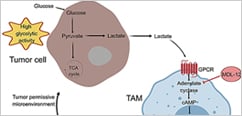Macrophages and their Markers

- On This Page
- Overview
- Macrophage markers
- References
Overview
Macrophages are found throughout the body in all tissues where they have a critical role in immune surveillance. Macrophages are able to modify their immunological response according to individual stimuli (Murray PJ & Wynn TA. 2011). In addition, macrophages also exhibit a phenotypic heterogeneity dependent on their local environment.
The function of macrophages can be divided broadly into two main roles; firstly they are involved in tissue maintenance (homeostasis), where macrophages clear apoptotic or necrotic cells and cell debris secrete growth factors and generally regulate tissue inflammation (Geissmann F et al. 2010).
Related Reading
Tumors sweet success due to macrophage polarization
Inking the immune system: how macrophages make tattoos last

Mini-Review
Macrophage Polarization
Read ReviewThe other main function is to identify and phagocytize foreign antigens from viral, bacterial and parasitic pathogens, followed by stimulation of the adaptive immune response by antigen processing and presentation.
In recognition of and in response to a stimuli, macrophages become activated resulting in changes which permit the uptake of the pathogen, induce production of inflammatory cytokines, activate signaling pathways, alter gene expression and induce acquired immunity (Geissmann F et al. 2010, Murray PJ & Wynn TA. 2011).
The process of macrophage activation is described as the polarisation of the macrophage into two distinct states; the classically activated M1 macrophage and the alternative activated M2 macrophage (Roszer T. 2015). More recent studies have shown that in fact there may be three further categories of macrophage; tumour associated macrophages, CD169+ macrophages and TCR+ macrophages (Chàvez-Galàn L et al. 2015). For an in-depth review of macrophage polarisation download our mini-review.
Macrophages are derived from a line of successive progenitor cells originating from the hematopoietic stem cell in the bone marrow. For the majority of macrophages this developmental process results in monocytes which leave the bone marrow moving into the blood stream, from here they then enter tissues during infection where they can differentiate into macrophages (Geissmann F et al. 2010).
Macrophage Markers
There are a large number of commonly used macrophage markers such as CD14, CD16, CD64, CD68, CD71 and CCR5; the exact marker to be used will be dependent upon the subset of macrophage and the conditions of their local environment. There are very few unique macrophage markers and often a number of markers will be required to identify your cell type. The table below lists key markers that can be used in the identification of various human and mouse macrophage subsets.
Key Macrophage Markers:
M1 |
M2a |
M2b |
M2c |
M2d |
TAM |
TCR+ |
CD169+ |
||||
CD86CD80CD68MHCIIIL-1RTLR2TLR4iNOSSOCS3 |
CD163MHCIISRMMR/CD206CD200RTGM2DecoyRIL-1R IIMouse only: Ym1/2Fizz1Arg-1 |
CD86MHCII |
CD163TLR1TLR8 |
VEGF |
CCL2CD3CD31CD68CD163HLA-DRIL-10iNOSPCNAVEGF |
CD68FynLATLckZAP70 |
CD11bCD11cCD68F4/80MHCII |
||||
Table constructed using data from Chàvez-Galàn L et al. 2015, Duluc D et al. 2007, Heusinkveld M and van der Burg H 2011 and Rőszer T 2015.
References
-
Chavez-Galan L. et al. (2015). Much more than M1 and M2 macrophages, there are also CD169+ and TCR+ macrophages.
Front Immunol. 6:263. -
Duluc D. et al. (2007). Tumor-associated leukemia inhibitory factor and IL-6 skew monocyte differentiation into tumor-associated macrophage-like cells.
Blood 110, 4319-4330. -
Geissmann F et al. (2010). Development of monocytes, macrophages and dendritic cells.
Science. 327(5966):656-661 -
Heusinkveld M and van der Burg H (2011). Identification and manipulation of tumor associated macrophages in human cancers.
J Transl Med 9, 216-229. -
Murray PJ. & Wynn TA. (2011). Protective and pathogenic functions of macrophage subsets.
Nat Rev Immunol. 11:723-737. -
Roszer T. (2015). Understanding the Mysterious M2 Macrophage through Activation Markers and Effector Mechanism.
Mediators of Inflammation. 2015:816460.







